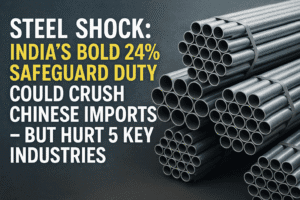Steel Shock: India’s Bold 24% Safeguard Duty Could Crush Chinese Imports – But Hurt 5 Key Industries
India is actively considering doubling its safeguard duty on steel imports to 24%, up from the current 12%, driven by concrete government concerns that Chinese producers are circumventing the existing tariff. This move stems from fears that steel displaced by US and global trade actions could flood the Indian market at unfairly low prices, threatening domestic manufacturers. While crucial for protecting India’s position as the world’s second-largest steel producer and stemming consecutive years as a net finished steel importer (near 10 million tonnes in FY25), the potential hike faces significant pushback.
Smaller downstream manufacturers, already squeezed by price rises following the initial 12% duty, warn a steeper increase would cripple them with unsustainable input costs. The government now faces the complex challenge of balancing the needs of large primary steelmakers against the survival of smaller industries reliant on affordable steel. Their decision must carefully weigh preventing predatory import pricing against triggering domestic inflation and harming broader industrial competitiveness.
This dilemma highlights the tension between immediate protectionism and fostering a sustainable, cost-competitive manufacturing ecosystem. The outcome will significantly impact jobs and growth across multiple sectors of the Indian economy.

Steel Shock: India’s Bold 24% Safeguard Duty Could Crush Chinese Imports – But Hurt 5 Key Industries
India’s steel industry stands at a critical juncture. Facing renewed fears of a potential surge in subsidized Chinese imports, the government is actively considering a significant escalation in its defensive measures – doubling the safeguard duty on steel imports from the current 12% to a hefty 24%. This move, revealed by senior officials, underscores the intense pressure on policymakers to shield domestic producers from what they perceive as an imminent threat.
The Spark: Circumvention Concerns and Global Trade Shifts
The trigger for this reevaluation isn’t abstract anxiety. Officials cite concrete “complaints of Chinese players trying to blunt the impact” of the existing 12% provisional safeguard duty imposed just months ago in late April (valid for 200 days). The concern is that Chinese exporters are finding ways to circumvent the duty, potentially routing goods through third countries or exploiting loopholes.
This threat is amplified by a broader global trade dynamic. As major markets like the US ramp up tariffs and other barriers against Chinese steel, there’s a palpable fear of “trade diversion.” India, with its massive consumption potential, is seen as a prime target for redirected Chinese steel, potentially sold at dumped or subsidized prices that could devastate local manufacturers.
The Stakes: Protecting Giants vs. Squeezing Small Fry
The stakes are undeniably high for India’s large steel producers. As the world’s second-largest crude steel producer, the health of this sector is vital for national manufacturing, employment, and strategic infrastructure development. The fact that India remained a net importer of finished steel for the second consecutive year in FY25 (with imports nearing 10 million tonnes) highlights the persistent vulnerability to cheaper foreign supplies, particularly from China.
However, the proposed duty hike is not a universally welcomed shield. A significant counter-narrative emerges from smaller Indian manufacturers – the downstream users of steel. These companies, operating in sectors like fabrication, engineering goods, and construction, are already feeling the pinch. They argue that the existing 12% duty has allowed large domestic steel mills to raise prices, significantly inflating their input costs. A jump to 24% could exacerbate this pain, eroding their competitiveness in both domestic and export markets.
The Government’s Tightrope Walk
Sources indicate the government is acutely aware of this complex dilemma. The challenge is striking a precarious balance:
- Protecting Primary Producers: Preventing predatory pricing and safeguarding investments and jobs in the core steel industry.
- Supporting Downstream Industry: Ensuring smaller manufacturers aren’t crippled by inflated raw material costs, preserving their viability and employment.
- Containing Inflation: Mitigating the potential for higher steel costs to ripple through the economy, impacting infrastructure projects and consumer goods.
Beyond the Duty: A Multifaceted Challenge
While the safeguard duty is a crucial tool, it highlights deeper questions:
- Competitiveness: Can Indian steel producers sustainably compete globally without relying solely on protection, especially on value-added products?
- Diversification: How can India reduce its reliance on volatile import markets and boost self-sufficiency in key steel grades?
- Policy Precision: Can measures be designed that effectively target unfair trade practices without indiscriminately harming downstream sectors?
The Road Ahead
The government’s deliberation on raising the duty to 24% signals heightened vigilance. However, the final decision, likely following a detailed investigation mandated for any permanent or higher safeguard measure, will be a critical test of economic policy balancing. It’s not just about keeping Chinese steel out; it’s about ensuring the overall health and competitiveness of India’s entire industrial ecosystem. The outcome will resonate far beyond the boardrooms of steel giants, impacting countless smaller businesses and the broader economy. The government’s move will reveal whether it can forge a shield that protects without stifling.
You must be logged in to post a comment.